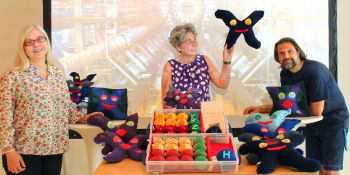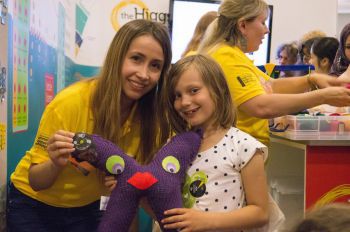Physicists celebrate second anniversary of discovery of the Higgs boson
Physicists from the University of Sussex working on the ATLAS experiment at CERN’s Large Hadron Collider took part in the 2014 Royal Society Science Exhibition in London (30 June–6 July), in coincidence with the celebrations of the second anniversary of the discovery of the Higgs boson.
 Professor Antonella De Santo, Dorothy Lamb and Dr Fabrizio Salvatore with their 'SUSY Softies'.
Professor Antonella De Santo, Dorothy Lamb and Dr Fabrizio Salvatore with their 'SUSY Softies'.
 The exhibition this year focused on the implications of this ground-breaking discovery, announced in 2012 by the ATLAS and CMS collaborations, and which is already associated with the Nobel Prize awarded to Professor Peter Higgs and Professor François Englert in 2013.
The exhibition this year focused on the implications of this ground-breaking discovery, announced in 2012 by the ATLAS and CMS collaborations, and which is already associated with the Nobel Prize awarded to Professor Peter Higgs and Professor François Englert in 2013.
The CERN Large Hadron Collider (LHC), an international project based at the CERN laboratory near Geneva in Switzerland, recreates conditions that existed in the Universe shortly after the Big Bang and aims at finding answers to some of the biggest questions in modern physics.
The team at Sussex is led by Professor Antonella De Santo and includes fellow academics Dr Fabrizio Salvatore, Dr Iacopo Vivarelli and Dr Alessandro Cerri, as well as many junior researchers and students.
The ATLAS experiment uses powerful beams of particles called protons, which are accelerated around the LHC’s 27-km underground tunnel. Protons are then crashed together in head-on at very high energies. In examining the products of these collisions, physicists expect to see major advances in their understanding of the laws of Nature.
The discovery of the Higgs boson marks a major breakthrough in physics, and started a new era of investigations. Scientists are now eagerly awaiting to collect more data at the LHC, to understand the fundamental properties of the Higgs boson and, it is hoped, make more groundbreaking discoveries.
The theme of the 2014 Royal Society Science Exhibition was "The Higgs Boson and Beyond", addressing questions such as: why is the mass of the Higgs Boson the one that has been measured, and can its value be explained by the new theory of Supersymmetry? Supersymmetry, or SUSY, predicts the existence “partners” of known particles, which have so far eluded detection. Some of these particles, called neutralinos, could explain the nature of Dark Matter, which constitutes about a quarter of our Universe.
For this year's exhibition, Professor De Santo and Dr Salvatore of the Sussex ATLAS team designed what have come to be known as the “SUSY Softies” – a set of knitted “particles” intended to explain some of the main features of Supersymmetry and in particular the properties of neutralinos.
Dorothy Lamb, Head of School's Coordinator in the School of Mathematical and Physical Sciences, who is also a talented artist, was the one to make the design a reality, knitting the neutralinos and all the other softies as glamorous as they could be!
Dr Salvatore said: "At Sussex we are very proud of our outreach programme. We are eager to engage with the general public in all possible ways and we are always keen to communicate our science.
"The exhibition was a huge success. In excess of 15,000 people are reported to have visited the Higgs Boson stand at the Royal Society over the week of the exhibition.
"The SUSY softies were undoubtedly among the most popular exhibit, well liked by both kids and adults. Some lucky winners were even able to take a softy home!”
The SUSY softies have become hugely popular on social media, as ATLAS re-tweeted pictures of them to their 20,000-plus followers.
